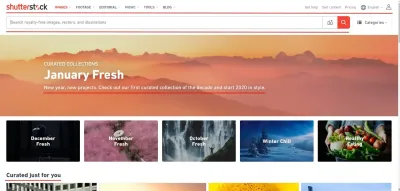If you’re part of a non-profit organization, you know how crucial it is to have access to high-quality images to tell your story, promote your cause, and inspire action. Shutterstock is one of the world’s leading stock image platforms, offering millions of photos, videos, and illustrations that can elevate your campaigns. But the cost can be a barrier, especially for organizations operating on tight budgets. Luckily, Shutterstock recognizes the importance of supporting non-profits and offers programs that can help you access their vast library for free or at a reduced cost. Let’s explore how this works and how your organization can benefit!
Understanding Shutterstock’s Non-Profit Program and Eligibility Criteria
Shutterstock’s Non-Profit Program is designed to make it easier for eligible organizations to access their extensive collection of media assets without the financial burden. The program typically offers free or discounted images, videos, and other creative resources, helping non-profits produce compelling content without stretching their budgets.
So, who qualifies? Generally, non-profit organizations involved in charitable, educational, or humanitarian work are eligible. This includes NGOs, community groups, educational institutions, and similar entities that operate for the public good.
To be considered, your organization usually needs to meet specific eligibility criteria, such as:
- Having official non-profit status (like 501(c)(3) in the U.S.)
- Providing documentation proving your non-profit status
- Demonstrating how the media will be used for non-commercial purposes aligned with your mission
It’s important to note that access to the program isn’t automatic. You’ll need to submit an application through Shutterstock’s dedicated non-profit portal, providing necessary documents and possibly explaining your organization’s work and how you’ll use the media resources. Once approved, you’ll gain access to Shutterstock’s library under special terms that support your non-profit initiatives. This program is a fantastic way to enhance your visual storytelling without the added expense, so it’s worth exploring if your organization qualifies!
Steps to Apply for a Free Shutterstock Account as a Non-Profit
Getting your non-profit organization set up with a free Shutterstock account might sound complicated at first, but it’s actually pretty straightforward once you know the steps. Here’s a simple guide to help you navigate the process smoothly:
- Verify Your Non-Profit Status: Before anything else, make sure your organization is officially recognized as a non-profit. This usually means having a valid 501(c)(3) status in the U.S. or an equivalent certification in other countries. You’ll likely need to provide proof of this status during the application process.
- Gather Necessary Documentation: Prepare documents such as your non-profit’s registration certificate, tax exemption letter, or any official documentation that proves your status. Having these ready will save you time.
- Visit Shutterstock’s Non-Profit Program Page: Head over to Shutterstock’s dedicated page for non-profit organizations. They often have a special application portal or contact info for organizations interested in free or discounted access.
- Complete the Application Form: Fill out the application form carefully. You’ll need to provide details about your organization, your mission, and how you plan to use the images. Be honest and clear—this helps Shutterstock understand your needs better.
- Upload Supporting Documents: Attach the proof of your non-profit status and any other requested documentation. Make sure your files are clear and legible.
- Submit Your Application: Once everything is filled out and attached, submit your application. Keep a copy of your confirmation and note any reference number or contact info provided.
- Wait for Approval: Shutterstock’s team will review your application. This process may take a few days to a couple of weeks. During this time, they might contact you for additional information or clarification.
- Receive Your Access Credentials: After approval, you’ll receive instructions on how to access your free Shutterstock account. Make sure to read all the guidelines—they often include important info on how to use the images appropriately.
Remember, the key is providing clear, honest information and supporting documents. Once you’re approved, you can start downloading high-quality images that will help bring your non-profit’s campaigns, newsletters, and social media to life—all without straining your budget!
Alternative Resources for Free Stock Images for Non-Profits
While Shutterstock is a fantastic resource, it’s not the only option out there, especially if you’re looking for free stock images suited for non-profit work. Luckily, there are several other platforms and sources that offer high-quality images without any cost. Here’s a quick rundown of some popular alternatives:
1. Unsplash
Unsplash is a favorite among non-profits for its vast library of beautiful, high-resolution images contributed by photographers worldwide. All photos are free to use for commercial and non-commercial purposes without attribution, making it perfect for non-profit needs. Just search for keywords relevant to your cause and find inspiring visuals.
2. Pexels
Similar to Unsplash, Pexels offers a wide range of free stock images and videos. Their collection is diverse, covering everything from community events to nature scenes. Their licensing is straightforward—use the images freely, even for promotional materials, without needing to credit the photographer (though attribution is appreciated).
3. Pixabay
Pixabay hosts a massive collection of free images, videos, and illustrations. It’s especially helpful if you need various media types for different projects. All content is released under Creative Commons Zero (CC0), meaning you can use, modify, and distribute the images freely.
4. Gratisography
If your non-profit wants something a little more unique or quirky, Gratisography offers creative, high-quality images that stand out. They’re free to use for any purpose, making them a fun resource for eye-catching visuals.
5. FreeImages
FreeImages provides a broad selection of stock photos in various categories. While some images require attribution, many are free to use with minimal restrictions. Always check the licensing details before downloading.
Additional Tips for Using Free Stock Images:
- Check licensing details: Even free resources can have restrictions. Always read the license to ensure you’re compliant.
- Credit when possible: While not always required, giving credit to photographers or sources can foster goodwill and support creators.
- Customize images: Use editing tools to crop, add overlays, or adjust colors to better fit your branding and message.
In summary, there’s no shortage of free stock image options for non-profits. By exploring these platforms, you can find stunning visuals that elevate your campaigns and outreach efforts—all without dipping into your budget. Combining these resources with Shutterstock’s program (when available) gives your organization a powerful toolkit for impactful storytelling through images.
Tips for Maximizing Your Shutterstock Subscription for Non-Profit Use
Now that you’ve secured a Shutterstock subscription tailored for your non-profit, it’s time to make the most of it! With thousands of high-quality images, videos, and illustrations at your fingertips, knowing how to utilize your resources efficiently can really boost your organization’s visual storytelling. Here are some practical tips to help you get the most out of your subscription:
Understand the Licensing Terms
First things first, familiarize yourself with Shutterstock’s licensing agreement. As a non-profit, you want to ensure you’re using images within the permitted scope—be it for social media, newsletters, websites, or printed materials. Most images are covered under a standard license, which allows for broad usage, but always double-check for any restrictions or special licensing requirements.
Create a Curated Library
Instead of searching from scratch each time, build a curated collection of images that resonate with your organization’s mission and branding. Save your favorite images into folders or collections within your Shutterstock account. This not only saves time but also ensures consistency across your visual content.
Use Advanced Search Filters
Shutterstock offers powerful search filters—like orientation, color palette, image type, and even people demographics. Use these tools to narrow down your options quickly and find exactly what fits your project. For example, if you’re designing a campaign about community outreach, filter for images of diverse groups in outdoor settings.
Leverage Batch Download Options
If your subscription allows, download images in batches to save time. Prepare your list of images beforehand, and then download them all at once. This approach is especially helpful when working on large projects like annual reports or multi-part campaigns.
Optimize Images for Different Platforms
Different channels may require different image sizes or formats. Use image editing tools to resize or crop images appropriately for social media posts, websites, or printed materials. This ensures your visuals look professional and are optimized for their intended use.
Stay Organized and Track Usage
Keep a record of which images you’ve used for various projects. This helps avoid accidental reuse of the same images without variation and makes future planning easier. Some organizations create a shared folder or spreadsheet to log image details, licensing info, and project context.
Engage Your Team
Encourage team members or volunteers to explore Shutterstock and contribute to your visual content pool. Sharing tips and best practices helps everyone make the most of your subscription, leading to more diverse and compelling visuals for your campaigns.
Conclusion and Additional Resources for Non-Profit Visual Content Needs
Securing a free Shutterstock account is a fantastic step forward in elevating your non-profit’s visual storytelling. Remember, the key isn’t just accessing images—it’s about using them thoughtfully and strategically to communicate your mission effectively. By understanding licensing, curating a library, utilizing search filters, and staying organized, you maximize the value of your subscription and create impactful content that resonates with your audience.
Beyond Shutterstock, there are other valuable resources to complement your visual content toolkit:
- Unsplash: Offers a vast collection of free, high-resolution photos for non-commercial and commercial use.
- Pexels: Provides free stock photos and videos with a broad range of categories.
- Canva: Great for creating custom graphics, social media posts, and presentations, often with free templates and elements.
- Creative Commons Search: Find images licensed for reuse with proper attribution.
Remember, compelling visuals can make a huge difference in engaging your community, attracting donors, and spreading your message. Keep exploring, experimenting, and sharing your stories visually—your audience will thank you!



